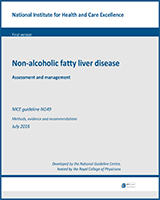NCBI Bookshelf. A service of the National Library of Medicine, National Institutes of Health.
National Guideline Centre (UK). Non-Alcoholic Fatty Liver Disease: Assessment and Management. London: National Institute for Health and Care Excellence (NICE); 2016 Jul. (NICE Guideline, No. 49.)
10.1. Introduction
Whilst weight reduction is commonly recommended in primary care for a host of co-morbidities including NAFLD, achieving and maintaining weight loss remains challenging for the majority of overweight or obese people. It is generally assumed, but not proven, that weight loss may help to reverse NAFLD, particularly as weight loss can lead to a preferential reduction in central abdominal fat compared to subcutaneous fat. This review seeks to determine whether there is evidence to support the assumption that weight loss would reverse NAFLD.
10.2. Review question: What is the clinical and cost-effectiveness of dietary interventions for weight reduction for adults, young people and children with NAFLD compared with standard care?
For full details see review protocol in Appendix A.
Table 49PICO characteristics of review question
| Population |
|
|---|---|
| Interventions |
|
| Comparison | No intervention, standard care (for example, general healthy eating advice rather than a more specific structured diet) or control |
| Outcomes | Critical outcomes:
|
| Study design | RCTs, systematic reviews of RCTs If no RCTs or SRs identified, comparative prospective cohort studies |
10.3. Clinical evidence
No relevant clinical studies were identified comparing very low calorie diets or calorie restriction diets with standard care.
10.4. Economic evidence
No relevant economic evaluations were identified.
See also the economic article selection flow chart in Appendix F.
10.5. Evidence statements
10.5.1. Clinical
- No relevant clinical studies were identified.
10.5.2. Economic
- No relevant economic evaluations were identified.
10.6. Recommendations and link to evidence
| Recommendation | 19.Offer advice on physical activity and diet to people with NAFLD who are overweight or obese in line with NICE's obesity and preventing excess weight gain guidelines. |
|---|---|
| Relative values of different outcomes | The GDG agreed that the outcomes that were critical to decision-making were progression of NAFLD, quality of life and occurrence of serious adverse events. The GDG considered weight loss, liver function test and adverse events to be important outcomes. No relevant clinical studies were identified for inclusion within the review. |
| Trade-off between clinical benefits and harms | The lack of relevant clinical studies meant that the GDG was unable to make a recommendation based upon this review. However, the GDG specifically noted that the absence of relevant clinical evidence should not be misinterpreted as evidence that weight reduction interventions in themselves are of no clinical effectiveness in the management of NAFLD. The GDG agreed that weight reduction advice is now widely viewed by clinicians as part of routine care for people with NAFLD, explaining in part why the evidence base for weight reduction interventions, in comparison to no intervention or standard care, is so limited. |
| Trade-off between net clinical effects and costs | No economic evidence was identified relevant to dietary interventions alone. The costs of dietary interventions would fall upon people with NAFLD as consumers, with the exception of initial counselling sessions to inform people on appropriate dietary changes and, later, sessions to encourage them to continue. If these sessions are brief, or contained within standard primary care consultations, then their cost will be modest. Consequently, if a dietary intervention was clinically effective, with evidence that people can adhere to it and with modest initial consultation costs, it would also be likely to be cost-effective from the perspective of the NHS. However, given that no clinical evidence has been found to demonstrate that specific dietary interventions are clinically effective, we cannot say that any specific dietary intervention will necessarily be cost-effective at a cost-effectiveness threshold of £20,000 per QALY gained. The cost-effectiveness of dietary interventions when adopted as part of a broader lifestyle intervention is considered in the review of lifestyle interventions (Chapter 13). |
| Quality of evidence | No randomised controlled trials or prospective cohort studies were identified that were relevant for inclusion. Whilst other literature relevant to the review question was identified (for example, conference abstracts), these were below the standard of evidence specified in the protocol. |
| Other considerations | The GDG noted that there are studies that examine diet in combination with other lifestyle interventions. These are assessed in Chapter 13. The GDG noted the guidance already published by NICE regarding weight loss in overweight and obese children, young people and adults (including PH47, PH53 and CG189) and agreed that the multi-component approach to management made in these recommendations is relevant and applicable to overweight and obese children, young people and adults with NAFLD. CG189 provides specific recommendations for management and therefore the GDG agreed to cross-refer to these recommendations. |
- Weight reduction interventions - Non-Alcoholic Fatty Liver DiseaseWeight reduction interventions - Non-Alcoholic Fatty Liver Disease
- Risk factors for NAFLD - Non-Alcoholic Fatty Liver DiseaseRisk factors for NAFLD - Non-Alcoholic Fatty Liver Disease
Your browsing activity is empty.
Activity recording is turned off.
See more...
